Many people have asked me this question, “how did this idea of doing Everest Base Camp come to you, and why?”
It’s quite the conversation starter, particularly when a group of trekkers meet each other for the first time. The truth is this – I don’t really know. For those who know me, I can make some key decisions simply on the basis of a gut feeling. I cannot really rationalize them in hindsight. But what I prefer to say for this EBC expedition is – I think the mountains were calling me!
I had zero experience at any ‘moderate to high complexity physical activities’ – i.e. no full marathons, no hiking, no competitive sports etc. I am a moderately fit 42 year old (nearly 43). Even if reluctantly, some of my fellow trekkers did say that going directly for EBC was a bit of a stretch – I should have started with something a bit more easier, and I agree with them.
Anyway, I did get there in the end. And what a sobering experience it was – physically obviously, but also mentally and spiritually.
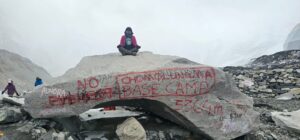
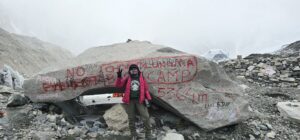 ~at the foothills of the Top of the World!~
~at the foothills of the Top of the World!~
THE PREPARATION
Planning starts when you receive the preparation list from the company you book with (you can also do this independently, but I wouldn’t advise that. Details on who I booked with are at the end of this blog). That list has everything from the gear you need to other miscellaneous items. For me it started to get real only when I finally bought the trekking backpack and started to fill it up – as lightly as possible. And even more real when I got the mandatory insurance, given the nature of this trek to cover for emergency evacuations and other possibilities. It sounds a bit over-the-top, but I will admit that I also had a Will ready, just in case (the husband was quite amused!) – I made it after I read the insurance document conditions.
A lot of people prepare quite a lot for this i.e. walking uphill ideally for long periods of time (minimum 6 hours and could go up to 11-12). But let me tell you this – absolutely nothing can prepare you for the terrain that is EBC, combined with the weather conditions and the altitude. The oxygen you take for granted can make its presence felt up there. I should have prepared a bit more, but it would have probably made a difference of 45-60 minutes to the climb i.e. 45-60 mins sooner. In other words, no matter what you do, it will be difficult – just the degree of difficulty can vary. Unless you are a very experienced climber.
THE UNEXPECTED
The trek was supposed to begin from Lukla which is 2,860m above sea level. And you get to Lukla via a flight from Kathmandu – its about 20-25 mins in a 14 seater plane. That never happened for my group. Weather conditions and other factors meant that we had to first drive to Ramechap airport (5-6 hours via difficult terrain) and then take a flight to Phaplu instead.
So on 5th April, at 12:00 a.m. our group set out from Kathmandu to Ramechap via a mini van. And in hindsight, I can’t believe that I was feeling cold then. It was nothing compared to what I was about to get into over the next 10 odd days, I just didn’t know it yet.


-12:00 a.m. at Kathmandu- – enroute Ramechap airport-
The flight to Phaplu (~2400m+ above sea level) was nerve-wracking. There were some tears and a lot of prayers by all 14 passengers, as the plane went through a lot of turbulence. It felt like it was made of paper. That smile in the photo outside the airplane was about to fade quickly!!
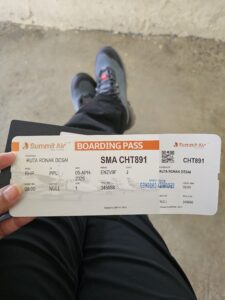
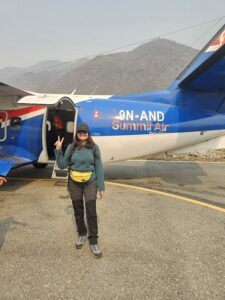
After reaching Phaplu, we set out for Surke, by car – it took us about 6.5 hours and it felt like one of those theme park rides. I have never been so happy to just get out of a car. It was about 5:45-6.00 p.m. This was the point to decide if we continue our trek by foot to Phakding which was the destination for Day 1 originally or stay back.
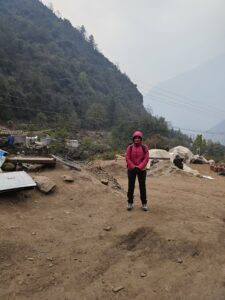
And I wish we would have stayed back. But the happiness of getting out of the crazy car ride was so great that it fueled my enthusiasm and made me forget that I had been up since 12 a.m. that day and Phakding was at least 6 hours away provided we walked at good speed. And so, we set off on foot and through nightfall. Let’s just say that in about two hours, I realized that I had made a mistake, but it was impossible to turn back now. Eventually, we never made it to Phakding – we had to stop and stay the night at a tea house in Tharakoshi – it was well after 9 p.m. and so we had been up and moving for about 21 hours at that point.
– at Surke and about to set off-
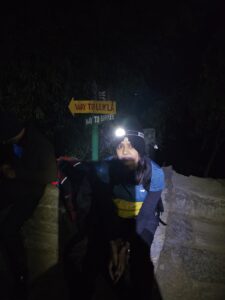
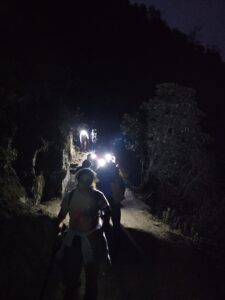
– trekking through nightfall, hoping to reach Phakding..-
So that night, when our guide did his briefing and said, “it will be a long day tomorrow and you report for breakfast at 5.30 a.m. I wanted to cry. I know it sounds ridiculous, but I truly did. I did hold it together though.
 -This is not a picture from that night, but its close enough!-
-This is not a picture from that night, but its close enough!-
The morning sun at Tharakoshi and some stunning views did lift my spirits next morning though and we set out for Namche Bazaar – elevation 3,440m above sea level – so we had to climb about 800m that day.
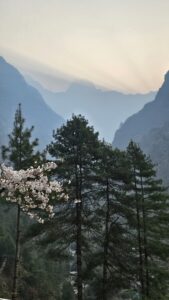
Now, ordinarily, we would have landed in Lukla, walked for about 3-3.5 hours downhill to Phakding and stayed the night there. But our first day already was a huge challenge – so going from that to Namche which is a tough climb was quite a big ask. And that day was definitely the most difficult day of my life. So much so that I nearly booked a helicopter back. It was my guide and some fellow trekkers who convinced me to keep pushing for just one more day. Today, I know that I would never have made it, if it wasn’t for them. And thank God for Diamox, Combiflam, Crocin and Volini.
“Nothing is wrong with you physically; it is just your mind. Don’t think.” – Prakash Raee, my guide.
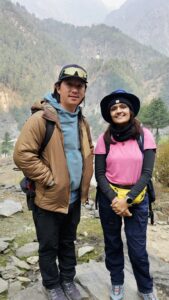
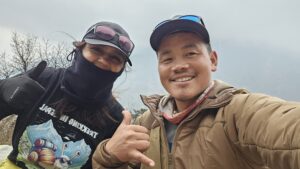
– With Prakash Raee – – With Anil Raee (our Assistant Guide)
Yet another highlight was meeting the legendary Sharad Kulkarni, a man who has scaled Mt. Everest – after age 50!
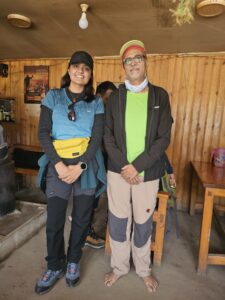
– With Sharad Kulkarni –
THE EXPERIENCE
The trek to EBC is a true test of physical but also mental endurance. I can walk you through the itinerary, but it will do nothing to give you a sense of what to expect. And frankly, other than a few bruises, I don’t really recall my experience physically – but maybe that’s just me.


– bruises from my hiking boots above my ankles, the swelling is gone –
The trek is a challenge to rise up above the chatter of your mind. And it will break you down somewhat in ways I cannot quite explain. You just have to embrace the process and get used to the sound of your own breath and putting one foot in front of the other, just focusing on that – and drink water every time you stop. Also, it is never a good idea to ask how much longer till the next break!
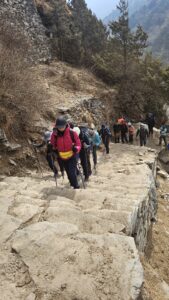
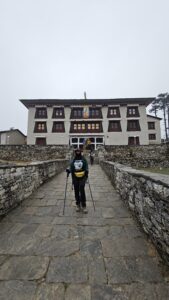
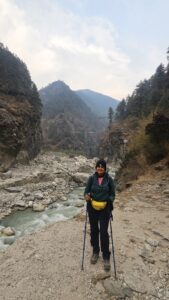
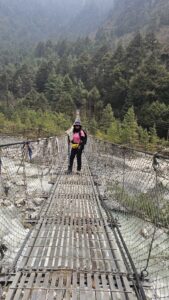
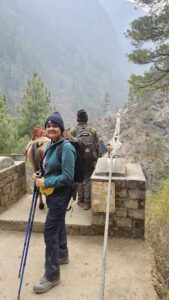
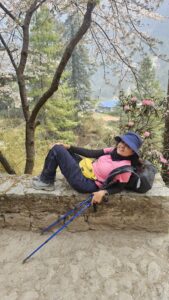
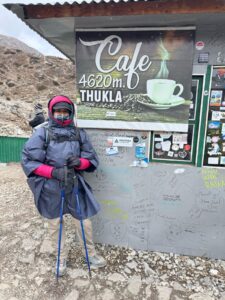
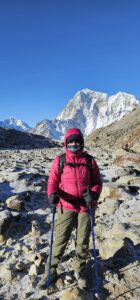
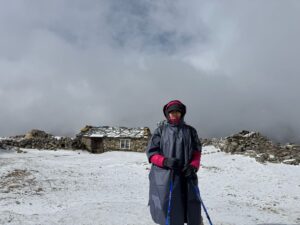
But then, through all that, suddenly, you turn a corner on the mountain and look around you – the insignificance of your being occurs to you. These mountains have been there for thousands of years, they would have watched so many people come and go. People who think the universe revolves around them, worrying about this and that. It is all meaningless – the things we worry about and spend our energy on sometimes. The only thing that is real and worthwhile – is compassion, towards yourself and others.
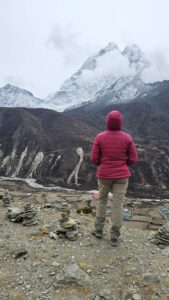
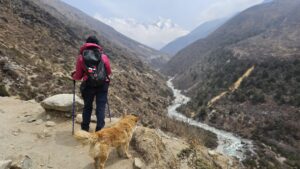
It will also occur to you how incredible the human spirit is. And how fragile your mind and body can be. In the face of some of these challenges, your own and the teams’ spirit carries you forward, long after your body might feel defeated and long after your mind starts to give up and give in. That should give you a perspective of priorities in your life.
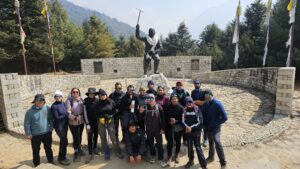
– Tenzing Norgay Centre, acclimatization climb, Namche –
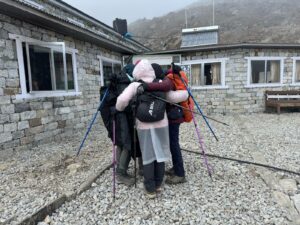
– Total strangers, we had made it to Gorakshep, 5140 m-
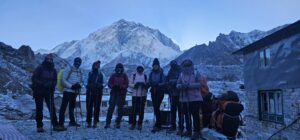
– D-day –
THE SUP-PORTERS
This blog would not be complete without a key mention – of the gentlemen who carried our big bags (20-23 kgs per person and each individual was carrying 2 bags). I have seen so many porters along this trek. And I honestly cannot imagine how we can allow this in the 21st century. Even the most experienced person on this trail wouldn’t be able to climb 20 steps with that load. The porters lead a difficult life – a life of extremely strenuous manual labor through the toughest terrain and weather – because they need to make a living. The more bags they can carry, the more they get paid. I know mountaineering and trekking is a business and passion for many – and it’s time that the role of the porters in making these dreams come true is revisited. Is it fair that a human being carries this kind of weight because there is no other way to make a living? And what about minimum wage? From all the discussions I had, neither the Government, nor the agencies think enough about this group – the people who aide these climbers and don’t appear on the final ascent celebration claims. I can tell you from experience that people spend more on a trekking bag and poles sometimes than what a porter will get paid.
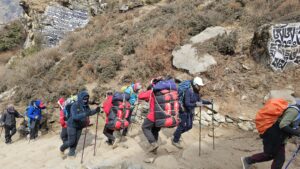
And so it is an appeal to anyone who reads this – just try carrying 50kgs up a flight of stairs and see how far you can go.. imagine doing that for 6-7 hours a day, every day and through biting cold and harsh winds sometimes. Every “passionate trekker / mountaineer” should revisit what % of their expedition cost is paid to a porter. What would you do without them? Here is hoping something changes and if anybody wishes to contribute feel free to reach out to me and I promise that the arrangements will be made to ensure that the porters receive it. You can write to me on rutaxdx@gmail.com.
I don’t know if more trekking awaits me in the future – it all depends on whether the mountains call me back! But I look forward to choosing compassion over everything else for the rest of my time on this planet.
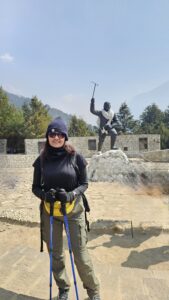
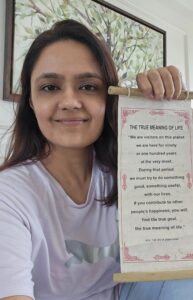
Ruta
P.S : I booked my trek via Himalayan Wonders. You should ask for Prakash and team as your guide if you choose to go. Don’t under estimate the trek.

You captured the physical challenge and emotional depth of the experience so beautifully, Ruta.
It felt like I was walking alongside you, feeling the altitude, the exhaustion, the awe, and the quiet triumph with each step.
What stood out most was how you balanced the grit of the trek with those reflective moments about resilience, perspective, and connection—with nature and with yourself. That’s not easy to put into words, but you did it with clarity and heart.
Thank you for sharing something so personal and powerful. It’s not just a travel story—it’s a human one.